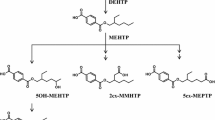Summary
Little is known about occupational exposure to the plasticizer di(2-ethylhexyl)phthalate (CAS number 117-81-7), a compound widely used in polyvinylchloride (PVC) plastics. We have studied the uptake of DEHP in workers by determining the concentrations of four metabolites of DEHP in urine samples, i.e., mono(2-ethylhexyl)phthalate (MEHP), mono (5-carboxy-2-ethylpentyl)phthalate, mono(2-ethyl-5-oxohexyl)phthalate, and mono(2-ethyl-5-hydroxyhexyl)phthalate. In addition DEHP concentrations in the air were determined by personal air sampling. Nine workers in a PVC boot factory exposed to a maximum of 1.2 mg/m3 DEHP showed an increase in the urinary concentrations of all four metabolites over the workshift. These results were obtained on both the first and the last day of the workweek. With the exception of MEHP, the increases in the concentrations of the metabolites during a workday were statistically significant. Six workers from a PVC cable factory exposed to a maximum of 1.2 mg/m3 DEHP showed a one-to fourfold increase in the concentrations of the four metabolites over the workshift, but these increases were not statistically significant. These results indicate that measurement of DEHP metabolites in urine samples may be of use for monitoring the occupational exposure to DEHP.
Similar content being viewed by others
References
Albro PW (1986) The biochemical toxicology of di-(2-ethylhexyl) and related phthalates: testicular atrophy and hepatocarcinogenesis. Rev Biochem Tox 8:73–119
American Conference of Governmental Industrial Hygienists (1986, with supplements till 1989) Documentation of the threshold limit values and biological exposure indices, 5th edn. Cincinnati, Ohio, pp 223–224
Astill BD (1989) Metabolism of DEHP: effects of prefeeding and dose variation, and comparative studies in rodents and the cynomolgus monkey (CMA studies). Drug Metab Rev 21:35–53
Burg RV (1988) Toxicology update. J Appl Toxicol 8:75–78
Conway JG, Cattley RC, Popp JA, Butterworth BE (1989) Possible mechanisms in hepatocarcinogenesis by the peroxisome proliferator di(2-ethylhexyl)phthalate. Drug Metab Rev 21:65–102
JLB Groot de (1987) Gegevens betreffende produktie, consumptie en afval van weekgemaakt PVC in nederland. TNO rapport 182/87
Diem K, Lenther C (1976) Wissenschaftliche Tabellen, 7th edn. Ciba-Geigy, Basel 546, 661
Elsisi AE, Carter DE, Sipes IG (1989) Dermal absorption of phthalate diesters in rats. Fundam Appl Pharmacol 12:70–77
International Agency for Research on Cancer (1987) IARC monographs on the evaluation of carcinogenic risks to humans. Supplement 7. Lyon
International Labour Office (1991) Occupational exposure limits for airborne toxic substances: values of selected countries. Occupational Safety and Health Series, No. 37. Geneva
Liss GM, Albro PW, Hartle RW, Stringer WT (1985) Urinary phthalate determinations as an index of occupational exposure to phthalic anhydride and di(2-ethylhexyl)phthalate. Scand J Work Environ Health 11:381–387
National Institute for Occupational Safety and Health (1977) NIOSH manual of analytical methods, vol. 3. Cincinnati, Ohio
Nielsen J, Åkesson B, Skerfving S (1985) Phthalate ester exposure — air levels and health of workers processing polyvinylchloride. Am Ind Hyg Assoc J 46:643–647
Rao MS, Reddy JK (1989) Peroxisome proliferation and hepatocarcinogenesis. Carcinogenesis 8:631–636
Rodricks JV, Turnbull D (1989) Interspecies differences in peroxisomes and peroxisome proliferation. Toxicol Ind Health 3:197–212
Schmid P, Schlatter C (1985) Excretion and metabolism of di(2-ethylhexyl)phthalate in man. Xenobiotica 15:251–256
Schulz C (1989) Assessing human health risks from exposure to di(2-ethylhexyl)phthalate (DEHP) and related phthalates: scientific issues. Drug Metab Rev 21:111–120
Stott WT (1988) Chemically induced proliferation of peroxisomes: implications for risk assessment. Regul Toxicol Pharmacol 8:125–159
Thiess AM, Fleig I (1978) Chromosomenuntersuchungen bei Mitarbeitern mit Exposition gegenüber Di-2-äthylhexylphthalat (DOP). Zbl Arbeitsmed 12:351–355
Turnbull D, Rodricks JV (1985) Assessment of possible carcinogenic risk to humans resulting from exposure to di(2-ethylhexyl)phthalate (DEHP). J Am Col Toxicol 4:111–145
Vainiotalo S, Pfäffli P (1990) Air impurities in the PVC plastics processing industry. Ann Occup Hyg 34:585–590
Author information
Authors and Affiliations
Rights and permissions
About this article
Cite this article
Dirven, H.A.A.M., van den Broek, P.H.H., Arends, A.M.M. et al. Metabolites of the plasticizer di (2-ethylhexyl) phthalate in urine samples of workers in polyvinylchloride processing industries. Int. Arch Occup Environ Heath 64, 549–554 (1993). https://doi.org/10.1007/BF00517699
Received:
Accepted:
Issue Date:
DOI: https://doi.org/10.1007/BF00517699




